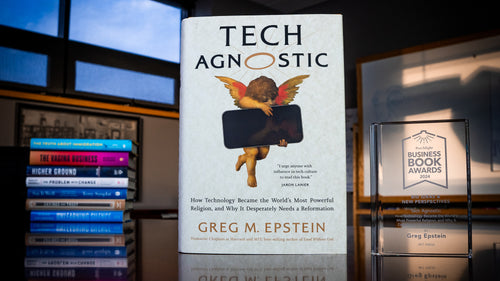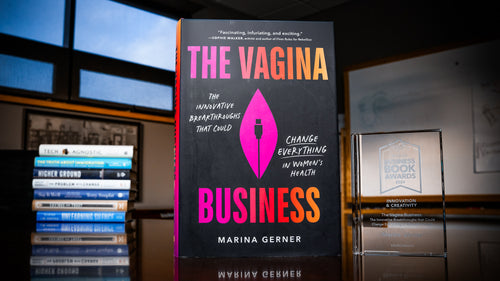The Creative Curve: How to Develop the Right Idea, at the Right Time

Allen Gannett is Founder and CEO of TrackMaven, a company that works with large brands to help them uncover the meaning—revealed by the patterns—within their marketing data. In working with major brands like Microsoft, Marriott, Saks Fifth Avenue, Home Depot, Aetna, Honda, and GE, Gannett noticed a significant pattern: most marketers, even well-known ones, weren’t hitting their goals. While their ad campaigns demonstrated creative thinking, their commercial success often fell short. He asked himself, could there be a method to combining creative and commercial success?
In The Creative Curve, Gannett overturns the mythology around creative genius and reveals the truth about creative success: that there is in fact a science behind what becomes a hit. New findings in neuroscience give us an unprecedented ability to decode and engineer the necessary moments of “inspiration” that create mainstream and popular work. Gannett says, “There is a pattern that successful creative people leverage to make hits, one that’s accessible to almost anyone. It’s intuitive, but it’s also learnable. And it has nothing to do with mysticism. You don’t need to do LSD to get inspired or pray for a simple moment of blinding inspiration.”
Gannett spent hundreds of hours with modern creative geniuses to find patterns to their achievement; ranging from world-renowned chefs to rock stars, and from Broadway sensations—like the team behind the Tony Award–winning show Dear Evan Hansen—to the founder of Reddit. Even more interesting, many were not aware they were following a pattern. They had all arrived at the same methods independently.
What the world’s most creative people repeatedly do—whether consciously or unconsciously—is find the point of optimal tension between familiarity and novelty, safety and surprise, similarity and difference. The Creative Curve reveals the learnable four-step process that they follow to find this sweet spot.
Harper has shared the following excerpt with us, adapted from The Creative Curve.
The Sitcom Secret to Creative Success
The creative process can seem like an enigmatic black box.
Most people imagine that creative powerhouses are successful because of some innate mojo or secret specialness that’s unavailable to the regular people of the world.
But that’s wrong. If my interviews with dozens of living creative geniuses have shown anything, it’s this: creative superstars aren’t born with some special gift. They’re successful because they understand how to harness the patterns underlying creative success. Following these patterns allows creative visionaries to consistently create ideas and products that are both new and familiar—a psychologically powerful combination that is sure to lead to views, likes, sales, and millions.
The secret to creative success isn’t rejecting popular patterns. Its remixing these patterns into something that has the excitement of “new” while still retaining the comfort of “old.”
Let me show you what I mean.
Black-ish is a hit ABC sitcom. To date it has run for four seasons, has an upcoming spinoff, Grown-ish, and has been nominated for both an Emmy and a Golden Globe as best comedy. It is the story of Dre, a father who grew up poor but is today an advertising executive. He and his wife, Rainbow, who is biracial, are raising four children. Black-ish explores Dre’s conflicts around wanting his kids to retain their identities and heritage at the same time as they focus on assimilating with their mostly white friends. In one episode, for example, Dre’s twelve-year-old son decides he wants a bar mitzvah for his upcoming birthday because he is envious of his Jewish friends.
For a work of fiction, Black-ish is more autobiographical than most TV shows. Kenya Barris, who created it, is the showrunner (a Hollywood term for the CEO of the show). Like the character Dre, he is married to a biracial doctor (also named Rainbow), grew up poor, works in a creative field, and has struggled to pass on his identity to his suburban children.
I wanted to know where the creative energy behind the show came from. So, I gave Barris a call.
People in L.A. are forever stuck in traffic and are, I find, very willing to talk on the phone about their creative process so long as neither of you minds an occasional car horn. As Barris and I spoke during his commute to work, he explained something interesting to me. A network sitcom episode has a traditional three-act structure, echoing the classic structure introduced by Aristotle in his Poetics in 335 b.c.
“The first act is going to be the introduction or thesis statement of what the particular topic or thing is,” Barris said. In the episode where Dre’s son wants to have a bar mitzvah, the topic on the table is one of cultural identity.
Barris went on: “The second act is going to be the body, or where you deal, where you unravel, where you get into the gooeyness and funniness of what this particular issue is, and how it relates to our family and how it has an unspooling within our particular characters’ lives.” In that episode, the second act has Dre calling a family meeting about his son’s identity crisis, and deciding that his son will instead go through a traditional African rite-of-passage ceremony.
“The third act would be the resolution, where you come to a place of what this information or what this topic or whatever the problem we put around this topic, how it’s dealt with and how it lands you in a satiating place for storytelling purposes.” In this episode, the resolution comes when Dre allows his son to have a hip-hop-themed bar mitzvah. He realizes that his children will have a different childhood from his, and that this evolution is simply part of life.
You might expect creatives to hate these structures, and see them as arbitrary rules forced on them by the establishment. Surprisingly, Barris finds that these constraints are critical to the success of any TV show.
“Without the act breaks, the stories don’t feel like they’re being told quite the same. I think that they actually do work. They help to organize our thoughts.”
As I went around interviewing creators, I found that the vast majority of them liked—if not loved—constraints. They didn’t view the popular patterns that developed in their specific industry with distaste or distain. Even though those patterns could be constraining, creators loved them!
But why? Why do creatives love constraints? The answer is simple: it makes them more effective.
Creative success isn’t about dreaming up something totally, completely, unbelievably different. Ideas that are too new won’t achieve mainstream success regardless of how good they are (case in point: imagine trying to introduce Dubstep in the 17th century). In order for an idea to become broadly successful, it needs to be new enough to be interesting but familiar enough to be accessible to most people.
And that’s where constraints are so helpful.
Constraints give creators a framework of familiarity within which to innovate. Barris is able to create an envelope-pushing show about an African-American family navigating the difficulties of modern life because the three-act structure provides enough familiarity to make the show accessible.
Chefs do the same thing. They experiment with ingredients and presentation. But these experimentations are almost always based off traditional recipes. The same is true with songwriters. Lyrics and notes change, but almost all musicians shooting for popular success stick to the verse-chorus form and keep their songs about 3 minutes long.
In every creative field, constraints give creators a foundation of familiarity on which to build their creative innovations. Without this foundation, many creative ideas would crumble under the weight of their own novelty.
While they can seem restrictive at first glance, constraints are actually one of the most important ingredients for creative success.
To create something new, you’re going to have to rely on something old.
Adapted from THE CREATIVE CURVE: HOW TO DEVELOP THE RIGHT IDEA, AT THE RIGHT TIME
© 2018 by Allen Gannett.
Published by Currency, an imprint of the Crown Publishing Group, a division of Penguin Random House LLC.
All rights reserved.
ABOUT THE AUTHOR
Only 26 years old, Allen Gannett is the founder and CEO of TrackMaven, a software analytics firm he launched five years ago that helps marketers find the patterns in their marketing data to prove their ROI and improve results. The startup has raised almost $30 million in institutional financing and has been used by Microsoft, Marriott, Saks Fifth Avenue, Home Depot, Aetna, Honda, Carnival Cruises, GE, MGM Resorts, MailChimp, Farmers Insurance, and more. Gannett is also an active angel investor and previously was a General Partner at Acceleprise, an early-stage venture-capital fund. He has been on the “30 Under 30” lists for both Inc. and Forbes.



